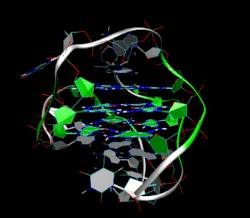G-quadruplex
Nucleic acid sequences that contain a particularly large amount of guanine are able to form four-stranded structures, which are called G-quadruplexes , G-tetrads or G4-DNA .
properties
G-Quadruplexes consist of a square arrangement of guanine molecules, which are stabilized by hydrogen bonds through the formation of Hoogsteen base pairs . In addition, they are stabilized by a monovalent cation , usually potassium , in the center of the tetrad. They can be generated from DNA , RNA , LNA and PNA and can be intramolecular, bimolecular and tetramolecular, that is to say composed of one, two or four subunits. Depending on the direction of the strands or sub-strands that form the tetrads, the structures are described as parallel or antiparallel .
The general sequence of G-quadruplexes is
- G3-5 NL1 G3-5 NL2 G3-5 NL3 G3-5
with any loops NL1-3, the length of which is between one and seven nucleotides .
Quadruplexes are less common in exons . The RecQ - Helicase , which causes Werner syndrome and binds to the Bloom syndrome protein, binds to G-quadruplexes . An artificial zinc finger protein called Gq1 has also been developed to fit G-quadruplexes, as well as their specific antibodies .
Cationic porphyrins also bind to G-quadruplexes, as does the telomestatin molecule.
Quadruplexes in the telomeres
The repeating DNA sequences of the telomeres of a wide variety of organisms form G-quadruplex structures. This could often be shown in vitro (“in the test tube”), in some cases also in vivo (in living cells). Telomeres in humans and all vertebrates consist of many repeats of the DNA sequence TTAGGG. The quadruplexes formed by this structure have now been well explored using NMR and X-ray structure analysis . The arrangement of these quadruplexes in the telomeres seems to reduce the activity of the enzyme telomerase , which is responsible for maintaining the length of the telomeres and plays a role in 85% of all cancers . This is an important approach to drug development.
Non-telomeric quadruplexes
Interest in quadruplexes that do not occur in telomeres has also increased recently. Responsible for this is Hurley's work with the proto-oncogene c- Myc , which apparently forms a quadruplex in a region that is hypersensitive to nuclease and which plays an important role in gene activity . It was then found that many other genes have G-quadruplexes in regions of the promoters , including the chicken beta-globin gene, the human ubiquitin ligase RFP2 and the proto-oncogenes c-kit, bcl-2, VEGF, H- ras and N-ras.
Overall studies of genomes for G-quadruplex formation have been performed which have identified 376,000 putative quadruplex sequences (PQS) in the human genome, although not all of them are likely to occur in vivo . A similar study discovered putative G-quadruplexes in prokaryotes . There are several conceivable ways in which quadruplexes could control gene activity, either through downregulation or upregulation. A possible model is clearly shown on the right, here a G-quadruplex in or near a promoter blocks the transcription of the gene, which deactivates it. In another model, a quadruplex on the non-coding DNA strand helps to keep the coding DNA open and thus improves the expression of the respective gene.
literature
- Stephen Neidle, Shankar Balasubramanian (Eds.): Quadruplex Nucleic Acids . Cambridge Royal Society of Chemistry, 2006, ISBN 978-0-85404-374-3 , doi : 10.1039 / 9781847555298 .
- Jay E. Johnson, Jasmine S. Smith, Marina L. Kozak, F. Brad Johnson: In vivo veritas: Using yeast to probe the biological functions of G-quadruplexes . In: Biochemistry . tape 90 , no. 8 , 2008, p. 1250-1263 , doi : 10.1016 / j.biochi.2008.02.013 , PMID 18331848 .
- Pooja Rawal, Veera Bhadra Rao Kummarasetti, Jinoy Ravindran, Nirmal Kumar, Kangkan Halder, Rakesh Sharma, Mitali Mukerji, Swapan Kumar Das, Shantanu Chowdhury: Genome-wide prediction of G4 DNA as regulatory motifs: Role in Escherichia coli global regulation . In: Genome Research . tape 16 , no. 5 , 2006, p. 644-655 , doi : 10.1101 / gr.4508806 , PMID 16651665 .
- Xu Hou, Wei Guo, Fan Xia, Fu-Qiang Nie, Hua Dong, Ye Tian, Liping Wen, Lin Wang, Liuxuan Cao, Yang Yang, Jianming Xue, Yanlin Song, Yugang Wang, Dongsheng Liu, Lei Jiang: A Biomimetic Potassium Responsive Nanochannel: G-Quadruplex DNA Conformational Switching in a Synthetic Nanopore . In: Journal of the American Chemical Society . tape 131 , no. 22 , 2009, p. 7800-7805 , doi : 10.1021 / ja901574c .
Web links
- Greglist - List of possible genes regulated by quadruplexes
- GRSDB - database with G-quadruplexes on RNA generation
- G-quadruplex Resource Site
Individual evidence
- ^ AK Todd, M. Johnston, S. Neidle: Highly prevalent putative quadruplex sequence motifs in human DNA. In: Nucleic Acids Res. (2005), vol. 33, no. 9, pp. 2901-2907. PMID 15914666 ; PMC 1140077 (free full text).
- ↑ S. Burge, GN Parkinson, P. Hazel, AK Todd, S. Neidle: Quadruplex DNA: sequence, topology and structure. In: Nucleic Acids Res. (2006), Vol. 34, No. 19, pp. 5402-5415. PMID 17012276 ; PMC 1636468 (free full text).
- ↑ a b c d J. L. Huppert, S. Balasubramanian: Prevalence of quadruplexes in the human genome. In: Nucleic Acids Res. (2005), Volume 33, No. 9, pp. 2908-2916. PMID 15914667 ; PMC 1140081 (free full text).
- ^ A. Siddiqui-Jain, CL Grand, DJ Bearss, LH Hurley: Direct evidence for a G-quadruplex in a promoter region and its targeting with a small molecule to repress c-MYC transcription. In: Proc Natl Acad Sci US A. (2002), Vol 99, No. 18, pp 11593-11598. PMID 12195017 ; PMC 129314 (free full text).


